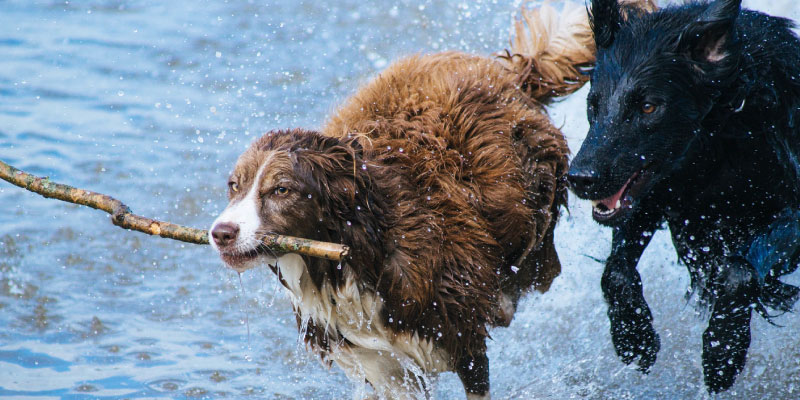Getting a new dog is the start of a lifetime of adventure. And, with a little bit of research, some patience, and plenty of understanding, those changes can be the best thing to happen to you. Here's the bit where you start your research on keeping your dog healthy and happy.

Whether that family is just you and the dog, or a whole pack of two legged and four legged friends, keeping every happy will take a little work, but it will be a whole load fun in the end.
So join us as we take a look at the four main areas in your life you might want to explore to keep your dog happy, healthy and active.
Because here at RuffRascals we are all about getting dirty, jumping in puddles, climbing mountains, and heading out to the nearest campsite for some adventures. But part of the fun of travelling is knowing that at the end of the day, coming home to your creature comforts is what makes it all worthwhile.
As far as we are concerned, a happy, healthy and active dog, makes happy, healthy and active people.
How to be active with your dog
There’s many reason you might want to get active and stay healthy. Maybe you just want to know the best way to get running with an already established doggy companion, maybe you don’t have a choice because your new energetic puppy demands more time and attention.
Either way, we have you covered. We’ve scoured our sources, and our own personal experience, to find out what you want to know about, and all the steps towards getting and staying active with your dog.
Most of you fall into two camps; you either want to start new adventures with your current pooch, or you already lead an active lifestyle and want to add a canine companion to the mix.
There’s a million ways to be active with your dog, from kayaking, to sledding, to travelling the world. But for the most part, it generally comes down to three main activities:
- You can be active by jogging or running with your dog
- You can be active by cycling with your dog
- You can be active by hiking, camping and hitting the great outdoors with your dog
We all know dog love nothing more than to be with us. Most (not all) love nothing more than being outside running, jumping and playing. And just like us, dogs can be trained to enjoy and safely appreciate all the activities that makes us happy.
That said, the best advice we could give you before you jump in is this: be patient with yourself and your dog.
Every puppy is different and they all have their own pace. Depending on their past, you may never get a dog to fully enjoy all the different adventures, but with a little resourcefulness, there’s still no reason they can’t join in most of your experiences in or out of the home.
How to go camping with your dog
If you’ve been camping before, chances are you’ve got the bug and want to go again. And whilst it may seem like the most natural thing to bring along your dog to all your outdoor adventures, you need to be prepared. Not just in training your dog, but making sure you get the right dog camping equipments.
Everyone has different needs and you will need to consider a whole facet of questions, such as:
- Is the camping site dog friendly?
- How can I safely tether my dog? What do I need to camp with my dog?
- Do I have a dog first aid kit if anything goes wrong and it’s not easy to get to a Vet?
- What if they get car sick on long travels?
And that’s just the start. There’s a myriad of small questions you’ve probably not even thought about. Like how do you get your dog to get used to the camping bed, tent and fires you might have around? And how on earth do you get the mud off their paws before they go trampling around inside our sleeping bag? Do they have to sleep outside, but is that really safe?
We answer all these questions and more here at RuffRascals, but if you don’t want to read much further then the best advice we can give you is to start by camping at home. Set up your campsite in your garden (if you have the space) or in your living room. Get your pooch used to the equipment, give them lots of treats, and slowly show them that this is a new way of living. Spend the night together in your new environment, and see how it goes.
Again, patience is key.
How to go running with your dog
This is by far the most common activity we get asked about when active people bring home a new puppy. When and how long till my dog can come running with me?
The walking pace of most medium dogs is about a light jog of a human. So it makes sense that if you are going to be out for half an hour or 30 minutes, you might as well exercise the dog and exercise the human. It’s like two pieces of a perfect puzzle.
However, not all dogs are made for running. Flat faced dogs or Brachycephalic dogs (pugs, bulldogs etc…) will not be able to go for a 5 mile run, hike or cycle. Some small dogs such as Dachshunds, Chihuahua or Shih Tzu will have no interest in going much further than to the bottom of the garden and back again.
That won’t change. But there are many special dog carriers you can get to bring along your pooch, or if you are active, make sure you pick a running dog breed that can keep up with you. And don’t think big is best: Terriers are small but mighty, and have the energy and pull to keep going even when you want to stop, whilst Great Danes can suffer from knee and hip problems if over-exercised.
As you well know with this sport: it’s all about training. Training you to keep up with your dog, and training your dog to keep up and not stray away from you. You can find many leads and equipments to help, but mostly what you need here is a slow steady pace to begin with, and a willing healthy dog who wants to join in the fun.
How to go cycling with your dog
Cycling with your dog is a little harder than running. Whether your dog can keep up with your cycling speed depending massively on the breed.
But you know what cycling is great for? Getting excess energy out of super active dogs. If you have an energetic medium to larger size dog who needs to burn off steam. This is it.
This activity is perfect for owners of working dog breeds: Australian cattle dogs, Labradors, Spaniels, Huskies, Vizlas. Chances are, if you have one of these at home, you’ll be wanting to get on your bike and ride into the sunset with your fur baby.
And even if you don’t, us humans have found wonderful an innovative ways to make sure that the four-legged friends in our lives never get left behind – from front or back facing dog carriers to full on dog bike trailers, carriers and baskets.
As with camping, the trick her is to go gently, give them a nice experience, and have fun with it. Bring the bike in the garden. Give them a treat when they go near. Throw treats from your bike for them to catch it, or get them to jump in and out of a non-moving trailer.
Keep the experience positive and your puppy will come to love those two wheels of yours.
How to keep your dog happy
One of the biggest misconceptions of owning a dog is that, once it’s in your home, you only need to walk them once a day and that its. Happiness quota reached. Work done. Just let them be.
And, you know, maybe some dogs like that do exist – after all, different dog breeds will have different characteristics, and some will be more independent than other.
Just like some parents out there are lucky enough to have newborns that sleep through the night from day 1. It happens.
The reality however is that dogs are fully conscious beings who feel boredom, tedium, and sadness, much like we do. They enjoy games, learning, toys and spending time with us. Sometimes that can feel like hard work when we all have busy lifestyles.
But no matter how little or how much time you have on your hands, there’s ways to making your pooch happy without having to break the bank or having 24 hour doggy daycare.
1. Teach dog tricks and play games
We all want well-behaved dogs. Teaching dog tricks, even just the basics of wait, sit, leave, are behaviours that are rewarding. Anything that get’s their brain working and make them feel good about themselves is good.
And despite what they say, you can teach old dog new tricks.
Dog brain games are perfect to tire out a clever dog that needs more than just a half an hour around the block. You don’t have to be a marathon runner to own a dog after all, most of us are happy to teach dogs to fetch. Some of us want to go a little further and do dog scent training, or set up agility courses in our gardens.
Whatever your level, there’s plenty of ways to play with your dog and plenty of tricks to get their brain ticking.
Each new trick will give them a new sense of confidence and create a stronger bond with you and your dog. And even if it’s old tricks, nothing makes a dog happier than having a purpose and your attention.
2. Get toys for them to play
If you don’t have the time to spend an hour a day doing tricks – thats fine. Whatever time you have, even a 5 minute game in the morning, or 10 minutes at night whilst watching TV can make a difference.
Let’s be clear: there’s no replacement for having direct and physical contact with your dog.
But we most of us have to go to work, we all have to leave them behind at some point, and we all have to deal with the guilt of the sad eyes as we close the door. Some (unfortunately) have to deal with more serious issues such as dog separation anxiety.
One of the ways you can help alleviate the boredom, and to free up a little bit of your time, is spend money on toys. Think of them as the iPad of the dog-rearing world. It’s not necessary, you can live without them, but you will probably need them at some points.
This is especially true of dog chews – dogs have a natural instinct to chew, and if you don’t give them something of theirs to get their teeth around, they will find something: kitchen cupboard, toilet paper, shoes… whatever is handy.
The many types of dog toys
Most toys for dogs will fall within one or more of the following categories:
- Balls, discs and throwers
- Natural Dog Chews
- Synthetic Dog Chews
- Dog pulls or tug of war
- Dog brain games and puzzles
- Electronic or Interactive dog toys
Unfortunately, you never know what your dog is going to love or hate. So we always recommend you start small and build up your dog toy collection.
Buy a selection of safe dog toys and see what works for your picky pooch… and maybe have a backup friend you can donate all the unwanted toys that just lay there, sniffed and ignored.
How to keep your dog healthy
We all want our dogs to live to be 110 years old, and the best way to that is, well… to keep them active and happy. Haven’t we already covered that?
That said, there is the more mechanical aspect of health – quite literally their muscles, their bones, their teeth, and everything else in between.
You never know what the future holds for your dog. Maybe you got a long lasting dog breed so you specifically so you don’t have to think about it for the next decade, but maybe you are unlucky enough that your dog needs special care and attention to get them over the long-life goal line. You just never know.
Either way, here at RuffRascals.com we cover all the nitty gritty details of how to keep your dog healthy and barking mad.
1. Feed them the best dog food
What are most common questions we get asked about?
Why is my dog not eating? I can’t train my dog as he is not food-led, help! My dog has a sensitive stomach and nothing I feed him helps, what do I do? I don’t have lots of money to feed them a raw food diet, what’s the best alternative? Is the raw food diet even good for dogs?
We don’t have all the answers. A lot of these questions are dependent on the dog itself. If your dog is fussy, maybe we could recommend switching to (if not raw) certainly fresh or gently cooked diet.
Which may be fine if you have a Jack Russel Terrier, but an Irish Wolfhound would equal the cost to having another human to feed every month. Is that something you can afford? If so, go for it.
But the end of the day, with dog food, you just need to do what’s best for your family and what’s best for your dog.
Of course the obvious recommendation is always to feed your dog the best most natural dog food you can find – if you can’t recognise the ingredients or they are not human grade, beware.
A lot of cheaper dog foods use substitutes such as sheep’s wool, slaughterhouse waste, or just plain water. Not bad for the dog, but hardly nutritious. Some can even have additives that can lead to bad behaviour, poor focus, and bad joints.
That said many dogs have thrived on tinned dog food for centuries. So what we are really saying is that whilst owning a dog can be expensive, it shouldn’t break the bank or your family.
There are perfectly good selections of dry dog food biscuits, wet food or even raw dog food recipes you can try at home. Maybe even mix it up.
Just make sure they get their recommended amount of vitamins and minerals in the mix, many of which you can buy as extra dog food supplements if you’re in doubt.
We’ve done some of the research for you, and put our findings down for you to look at. But ultimately, you have to make the decision for what’s best for your dog.
2. Dog and Pet Insurance; boring but necessary
Look, we know this isn’t a glamorous section, but we all have to read up on it and make the best decision.
Picking the right pet insurance for your dog is important because you don’t know what the future holds. Maybe he/she get olds and goes to sleep one day, without ever having experienced a twinge in their knees. We hope so.
But at the very least your dog will need yearly booster shots and dog vaccination to ensure that they don’t get anything for the future. So instead of pet insurance, you might want to just get on a loyalty scheme with your Vet.
Whatever the case, it is worth looking at the different types of dog insurance you can get, and why it’s important to get something. Do you want to look down at an expensive Vet bill, panic building up not knowing how you’ll afford the next month, or do you want to go home, happy that your pooch is safe, healthy, and you can claim the majority of the costs back?
Dog insurance won’t make your dog happier. But much like vaccinations and microchips, it will give you peace of mind and (hopefully) many happy years of dog ownership.
3. Give your dog a safe space and a good dog bed
What are the two things you need to buy when you bring home a puppy? A bed and food bowl. That’s it.
But what kind of dog bed is best for you dog? You’d think all you need is a blanket, but a dog bed is so much more than that.
A dog bed is a safe space for your dog to retire too when he’s had enough, not just when he needs to rest and sleep. It’s just good for their mental health and their confidence in making your home their home. It can also help with stress, anxiety, and even aching joint depending on the type of dog bed you choose.
Whether you are looking at how to crate train your dog, need a raised dog bed for hot weather, or need a cave to help an anxious dog, you’ll be surprised by the variety, purpose and usefulness of dog beds.
And, let’s not forget, that whilst your puppy may be happy to just snuggle in an old blanket at 2 months, when your 12 year old ‘puppy’ slowly gets up, he may need an orthopaedic dog bed to help him up and out in the morning.
Plus, let’s not forget, your new dog bed is now part of your home furniture. You might as well have fun shopping for the perfect one, two or five you’ll need to keep your pooch healthy and happy.
4. Be patient and gentle with “bad” behaviour
Bad behaviour is hard to define. Sure, we can say that a dog has been bad if he attacks a stranger, but is that bad, innate, or trained? We don’t think that any dog is truly bad, but we do know that some dogs will need more training than others.
All dogs are different and all dogs will have their own quirks. Spaniels are notoriously scent led, meaning they can get easily distracted when out and about and forget to check in with the pack (you). So you need to do a lot of proximity training with them.
Terriers and Dachshunds were specifically bred to go digging for mice and rats. Welcome to a garden full of holes. Boxers, on the other hand, were bred to help control cattle, and are still considered a working dog which means lots of energy. How do they get it out? Well, there’s a reason why YouTube is filled with ‘destruction disasters’ when a Boxer was left home alone for too long.
We are not saying if you get this kind of dog breed you’ll definitely have problems, we are saying that most dogs are bred for a purpose, meaning they can be more or less inclined to certain behaviours. But if you can understand your dog, and what he needs, you may find that any behaviour can be taught, untaught, or re-directed in a positive way.
Most of the difficult dog behaviours we get asked about include:
- How to train a non-food led dog
- How to stop your dog from wandering
- How to stop your dog from excessive barking
- How to stop your dog from chewing and destroying household items
- How to stop your dog from biting or nipping at your hands or heels
- How to get good recall from your dog
- How to bond with your dog
That last one is especially important if you’ve taken the amazing decision to get a rescue dog. There’s a lot of beautiful animals who just need a caring and gentle hand to help them become amazing pets.
Talk to your dog kennel or rescue centre if you are not sure about the breed. They will know the temperament of your dog, and help you pick one that suits your lifestyle and experience.
Or if you’ve had your heart set on a breed, just do your research. Read up on everything, and watch that the behaviours you don’t want don’t then get reinforced by what you do.
And finally, if you are a beginner dog owner, and you haven’t been absolutely overwhelmed by now by all the information we’ve thrown at you, why not take a read through our best dog breed for beginners? It’s a good place to get started.
At the end of the day, the best dog for you is whichever one, through luck, fate and some work, find its way into your home.
With a little training and a whole load of love (and maybe a few dog gadget and tools), there’s nothing stopping you and your dog from having a happy, healthy and active life.
We can’t wait to hear about all your doggy adventures. Get in touch with us if you have any specific questions or just want to share in your successes! We can’t promise to answer all questions, and we are not Veterinarian. But we can promise that if we see enough people ask for something, we will go out there and find the right expert to get the answer on our dog problem blog.
If in doubt, always remember that your Veterinarian was trained for this. Don’t doubt yourself, ask for help from a medically trained professional and keep your dog safe and happy.




